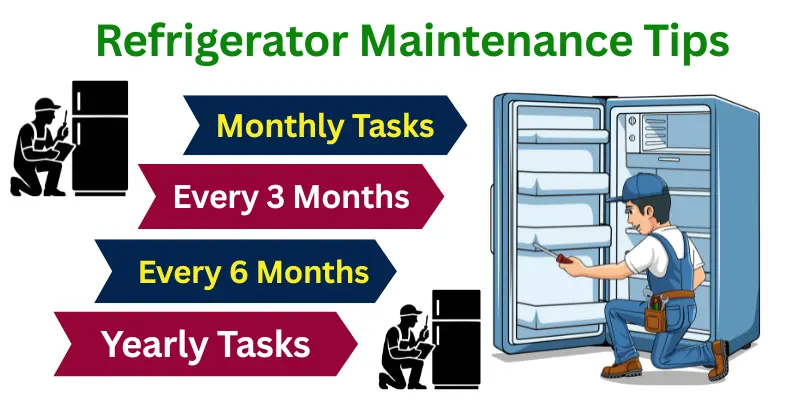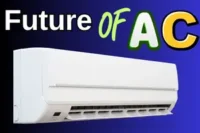Refrigerator Maintenance Tips to Keep Your Fridge Running Well
Published: 27 Oct 2025
Last summer, Maneha noticed her fridge was making a loud humming sound. At first, she ignored it. A week later, the fridge stopped cooling, and she had to throw away all the food inside. The repair bill was much higher than she expected. If she had followed simple refrigerator maintenance tips like cleaning the coils and checking the door seals, she could have avoided the trouble.
Are you ready to learn these simple fridge maintenance tips and keep your fridge running smoothly? Let’s begin.
Top Fridge Maintenance Tips
We have arranged all refrigerator maintenance tips in a simple order for you. Some should be done every month, some every three or six months, and a few only once a year. In this guide, we will first give you the full list at the top, and then explain each tip one by one in detail so you know exactly what to do and when.

Before we go into detail, let us share with you a list of fridge maintenance tips. It will help you understand in a very easy way. Let’s see together.
Monthly Tasks
- Wipe shelves, drawers, and door bins with mild soap.
- Clean spills immediately to avoid odors.
- Check and adjust food placement (don’t block vents).
- Use airtight containers or wraps for leftovers.
- Place an open box of baking soda to absorb smells.
- Check the temperature with a fridge thermometer.
Every 3 Months (Quarterly)
- Vacuum or brush condenser coils (if dusty, do so sooner).
- Inspect and clean door seals (do the paper test).
- Empty, clean, and refill the ice maker tray.
- Check water filter (replace if needed).
- Wash and disinfect the vegetable drawer.
- Look for leaks under and behind the fridge.
Every 6 Months (Bi-Yearly)
- Defrost freezer if ice build-up is over ¼ inch (manual models).
- Clean the drip pan and drain hole to prevent clogs.
- Level the fridge and adjust doors if seals don’t close tightly.
- Test light bulbs, replace if weak or burnt out.
- Deep-clean fan blades (evaporator and condenser fans).
Yearly Tasks
- Replace water and air filters (if not changed earlier).
- Tighten loose hinges, handles, or shelving parts.
- Inspect wiring and power cord for wear.
- Call a professional technician for a quick check-up.
- Review energy use: if bills are high, check for hidden problems.
Refrigerator Maintenance Tips You Need Every Month
A little care each month keeps your refrigerator running smoothly and smelling fresh. These simple tasks don’t take much time, but they stop problems before they grow bigger. Regular cleaning and small checks also help your fridge stay energy efficient. With just a few minutes of effort, you can save food, money, and future repair costs.
Wipe Shelves, Drawers, and Door Bins
Cleaning stops stains, smells, and bacteria from building up.
- Remove shelves, drawers, and bins from the fridge for easy cleaning.
- Wash them with mild soap and warm water, not harsh chemicals.
- Use a sponge or soft cloth to avoid scratching the surface.
- Dry everything fully before putting it back to prevent moisture build-up.
- Do this at least once a month, or more often if food spills happen often.
Clean Spills Immediately
Spills can cause sticky messes and bad odors if ignored.
- Wipe spills right away using a damp cloth or sponge.
- For tough stains, use a mix of baking soda and warm water.
- Remove food items near the spill to clean the area properly.
- Dry the surface with a clean cloth before putting food back.
- Clean small leaks from bottles or containers before they spread.
Check and Adjust Food Placement
Good airflow keeps food evenly cool.
- Do not block the vents inside the fridge with large boxes or bottles.
- Keep dairy items like milk and cheese in the colder back sections.
- Store raw meat or fish on the lowest shelf to prevent dripping.
- Leave some space between items so air can move around freely.
- Use fridge drawers for fruits and vegetables to keep them fresh.
Use Airtight Containers or Wraps
This keeps food fresh and prevents strong smells from spreading.
- Store cooked food in sealed, airtight containers.
- Wrap fruits and vegetables in breathable bags to prevent spoilage.
- Cover strong-smelling foods like onions or fish tightly.
- Use transparent containers so you can see the contents easily.
- Label containers with dates to avoid keeping old food too long.
Place an Open Box of Baking Soda
Baking soda absorbs unwanted smells inside your fridge.
- Keep a small open box of baking soda on the middle shelf.
- Replace it every three months for the best freshness.
- Shake the box lightly once in a while to refresh it.
- Keep it away from spills or liquids to avoid clumping.
- Use two small boxes if your fridge is large or heavily packed.
Check the Temperature with a Fridge Thermometer
The right temperature keeps food safe and energy use low.
- Place a fridge thermometer inside for accurate readings.
- Keep fridge temperature between 37–40°F (3–4°C).
- Keep freezer temperature at 0°F (-18°C).
- Adjust the settings if food spoils quickly or freezes in the fridge.
- Recheck temperatures after adjusting, as it takes a few hours to settle.
Every 3 Months Refrigerator Maintenance Tips
Doing these tasks every three months keeps your fridge running smoothly and worry-free. They help stop small issues from turning into expensive repairs later. A little seasonal care also improves cooling, saves energy, and keeps food fresh longer. Think of it as a simple health check-up for your refrigerator.
Vacuum or Brush Condenser Coils
Dusty coils make the fridge work harder and waste energy.
- Unplug the fridge before cleaning for safety.
- Locate the coils (usually at the back or bottom).
- Use a vacuum with a brush attachment to remove dust.
- For tight spots, use a coil cleaning brush.
- Clean the surrounding floor area to stop dust from returning quickly.
Inspect and Clean Door Seals
Door seals keep cold air inside and stop energy loss.
- Wipe the seals with warm, soapy water to remove dirt.
- Check for cracks or tears in the rubber.
- Test with the paper trick: close a paper in the door – it should hold tightly.
- If the paper slips out, the seal may need replacing.
- Keep seals dry to prevent mold or mildew build-up.
Empty, Clean, and Refill the Ice Maker Tray
Dirty ice trays can affect ice quality and taste.
- Turn off the ice maker before cleaning.
- Remove all ice cubes and discard old or clumped ones.
- Wash the tray with warm, soapy water and rinse well.
- Dry completely before refilling with fresh water.
- Restart the ice maker and check that it makes clear, clean ice.
Check Water Filter
A clean water filter keeps drinking water fresh and safe.
- Locate your fridge’s water filter (check the manual if unsure).
- Inspect for dirt or discoloration inside the filter.
- Replace it every 3–6 months, depending on use and model.
- Reset the filter light if your fridge has one.
- Always use filters recommended by the manufacturer.
Wash and Disinfect the Vegetable Drawer
Vegetable drawers often trap moisture, dirt, and bacteria.
- Remove the drawer and wash it with warm, soapy water.
- Disinfect with a vinegar-water mix or mild kitchen cleaner.
- Dry fully before placing it back inside.
- Store vegetables in breathable bags to avoid excess moisture.
- Repeat this every 3 months or sooner if spills happen often.
Look for Leaks Under and Behind the Fridge
Leaks can lead to water damage and mold.
- Pull the fridge slightly away from the wall.
- Check the floor underneath for puddles or damp spots.
- Inspect the water line if your fridge has an ice or water dispenser.
- Clean the drain pan and check for cracks.
- If leaks continue, call a technician to inspect further.
Every 6 Months Refrigerator Maintenance Tips
Doing these tasks twice a year helps your fridge stay efficient and reliable. They reduce the chance of sudden breakdowns that can spoil food and cost money. This deeper cleaning and adjustment also keeps cooling strong and balanced. It’s like giving your refrigerator a mid-year service to keep it in top shape.
Defrost the Freezer (Manual Models)
Too much ice build-up reduces space and cooling efficiency.
- Check the freezer walls for frost thicker than ¼ inch.
- Turn off the freezer and unplug the unit before defrosting.
- Remove food items and place them in a cooler with ice packs.
- Let the ice melt naturally or speed it up with bowls of hot water.
- Wipe dry and restart the freezer once ice is fully gone.
Clean the Drip Pan and Drain Hole
The drip pan collects water and can cause bad smells if it is dirty.
- Locate the drip pan at the bottom of your fridge.
- Slide it out carefully and empty any water.
- Wash it with warm soapy water and disinfect if needed.
- Check the drain hole for clogs and clear with a soft brush or pipe cleaner.
- Replace the pan and make sure it’s seated correctly.
Level the Fridge and Adjust Doors
A fridge that isn’t level can cause doors not to close properly.
- Place a bubble level on top of your fridge to check the balance.
- Adjust the front legs or rollers until the fridge is even.
- Test the doors – they should close tightly on their own.
- If doors don’t seal, adjust hinges or tighten screws.
- Proper leveling also reduces motor strain and noise.
Test and Replace Light Bulbs
Good lighting helps you see food clearly and reduces waste.
- Open the fridge and freezer to check the lights.
- Replace weak bulbs, flickering, or burnt-out bulbs.
- Use only bulbs recommended in your fridge manual.
- Wear gloves or use a cloth when handling new bulbs.
- Dispose of old bulbs safely to avoid injury.
Deep-Clean Fan Blades (Evaporator and Condenser Fans)
Fans keep air moving and help with cooling. Dust makes them noisy.
- Unplug the fridge before cleaning for safety.
- Locate the evaporator fan (inside freezer) and condenser fan (back/bottom).
- Use a small brush or vacuum attachment to remove dust and dirt.
- Wipe blades gently with a damp cloth if needed.
- Make sure fans spin freely before restarting the fridge.
Yearly Refrigerator Maintenance Tasks
These tasks only need to be done once a year, but they are very important for your fridge. They help keep it safe, energy-efficient, and working for many more years. A yearly check also catches hidden problems before they become costly repairs. Think of it as your refrigerator’s yearly health check-up for long-lasting performance.
Replace Water and Air Filters
Filters keep your fridge clean, safe, and fresh.
- Change the water filter if you have not replaced it earlier.
- Swap the air filter to keep odors under control.
- Always use filters recommended by the manufacturer.
- Write down the replacement date for next year’s reminder.
- A fresh filter also improves the ice and water taste.
Tighten Hinges, Handles, and Shelving Parts
Loose parts can affect use and safety.
- Check fridge and freezer door hinges for looseness.
- Tighten handles to prevent them from breaking.
- Inspect shelves and drawers for cracks or wobbles.
- Replace broken plastic parts with new ones.
- Keep screws and small fittings secure for daily use.
Inspect Wiring and Power Cord
Electrical safety is very important for fridges.
- Pull the fridge slightly away from the wall to see the back.
- Check the power cord for cuts, cracks, or exposed wires.
- Look for signs of overheating, like burn marks.
- Do not tape damaged wires – replace the cord if needed.
- If you see damage, call a professional electrician.
Call a Professional Technician
A yearly check-up keeps your fridge in top shape.
- Schedule a service visit with a trusted fridge technician.
- Ask them to check the compressor, fans, and refrigerant.
- Get advice on parts that may need replacing soon.
- A pro can spot small problems before they become big.
- This also helps your fridge last many more years.
Review Energy Use
High electricity bills can indicate hidden problems with your fridge.
- Compare your current bills with last year’s usage.
- If costs are higher, your fridge may be working too hard.
- Check seals, coils, and fans for dirt or leaks.
- Consider upgrading if your fridge is more than 10–15 years old.
- New energy-efficient models can save money in the long run.
Common Questions and Answers About Fridge Maintenance Tips
We already explained all the fridge care tips in detail, but you may still have some small questions in your mind. Don’t worry, you are not alone. Many people ask the same things. That’s why we made this bonus FAQ list just for you. It will clear your doubts and make everything easy to understand.
- Can I run my fridge when it’s completely empty?
- What foods should never be stored in the fridge?
- Does keeping the fridge too full affect cooling?
- Does an old refrigerator use more electricity than a new one?
- How can I tell if my fridge is using too much energy?
- Should I switch off my fridge when going on vacation?
- How long can food stay safe in the fridge during a power outage?
- Can placing a fridge near a stove or sunlight affect its performance?
- What is the best way to organize food in the fridge for longer freshness?
- How do I know when it’s time to replace my refrigerator?
Now we will discuss the answer to each question in detail. So, are you ready? Let’s see.
It is safe to run a fridge when it is empty, but it is not ideal. An empty fridge wastes more energy, and the compressor cycles more often.
- A full fridge holds cold better. This is called thermal mass.
- When it is almost empty, the fridge turns on and off more. This uses more electricity.
- If you must run it empty, add bottles of water or jugs to fill some space.
- For long periods away, it is better to clean, unplug, and leave the door open a little.
- If you keep it empty but running, check the power bill and the fridge often.
Some foods lose taste or change texture in the cold. Keep these at room temperature instead.
- Bread gets stale faster in the fridge. Store it in a breadbox or freezer.
- Potatoes and sweet potatoes turn gritty and sweet when cold. Keep them in a cool, dark place.
- Tomatoes lose flavor and get mealy in the fridge. Store on the counter until ripe.
- Onions (whole) and garlic last longer in a dry, cool cupboard, not the fridge.
- Olive oil can thicken in cold weather. Keep it in a dark cupboard away from heat.
Yes. A too-full fridge can block airflow and make cooling uneven. That harms food and makes the fridge work harder.
- Air needs space to move. Don’t pack items tightly around vents.
- Cold spots and warm spots can form when air can’t flow.
- The compressor may run longer and use more power.
- Leave small gaps between items so air can pass.
- Use clear bins to group items and keep order without stuffing.
Yes, older fridges generally use more energy. New models are more efficient and save money over time.
- New fridges use better insulation and smarter compressors.
- Old seals, dirty coils, or worn parts make older units work harder.
- If repair costs rise, compare them to the price of a new, efficient model.
- Look for energy labels when you buy a new fridge.
- If your fridge is over 10–15 years old, it may be time to think about replacing it.
You can spot signs at home and check bills to see if the fridge is costing more than it should.
- Watch your electricity bill. A sudden rise may mean the fridge works harder.
- The fridge runs all the time, or the motor sounds loud. This is a red flag.
- The fridge feels warm inside, or food spoils faster than before.
- Check door seals, clean coils, and test the temperature with a thermometer.
- Use a plug-in energy meter to measure the fridge’s actual power use if you want precise data.
- If cleaning and simple fixes do not help, call a technician to inspect it.
It depends on how long you will be away. Short trips – keep it running. Long trips – clean and switch it off.
- For short trips (a few days), keep the fridge on and leave food safe.
- For long trips (weeks), empty the fridge, clean it, and unplug it.
- Leave the door slightly open to stop mold and smells when unplugged.
- Turn off the water line to the ice maker if your model has one.
- If unsure, follow the fridge manual for “vacation” or “storage” tips.
It depends on how long the power is out and how full your fridge or freezer is. Keep doors closed to keep out the cold.
- A full freezer keeps food frozen about 48 hours; a half-full freezer about 24 hours.
- A refrigerator stays cold for about 4 hours if you keep the door shut.
- Use a thermometer to check the food temperature later.
- Throw away perishable food that has been above 40°F (4°C) for more than 2 hours.
- When power returns, check food for unusual odor, color, or texture before eating.
Yes. Heat from a stove or the sun makes the fridge work harder and use more energy.
- Heat raises the fridge’s outer temperature. The compressor must run longer.
- Avoid placing your fridge next to ovens, stoves, or direct sun.
- Leave a few inches of space on the sides and back for airflow.
- If you cannot move it, lower the thermostat a little and clean the coils more often.
- A shaded, well-ventilated spot works best for long life and low energy use.
Use zones and simple rules. This helps food last longer and keeps your fridge tidy.
- Top shelf: ready-to-eat foods and drinks.
- Middle shelves: leftovers and cooked food in sealed containers.
- Bottom shelf: raw meat and fish in a leak-proof tray.
- Drawers: fruits and vegetables (separate if possible). Use crispers for produce.
- Door: condiments and items that tolerate small temp changes (not eggs or milk).
- Label food with date and use older items first (first in, first out).
Look at age, repairs, and energy cost. Several warning signs mean replacement may be best.
- Older than 10–15 years is a common sign to consider replacing.
- If repair costs are high or frequent, replacement may be cheaper long-term.
- If the fridge runs nonstop, makes loud noises, or does not cool well, it may be failing.
- High energy bills and poor performance point to inefficiency.
- If you see rust, refrigerant leaks, or burned wiring, replace it for safety.
Now, the time to say goodbye is almost here, but before that, we have prepared a final conclusion for you. Don’t forget to read it, which will make it easier for you to decide. Let’s see in the next section.
Final Thoughts, My Champion
So, guys, in this article, we’ve covered Refrigerator Maintenance Tips in detail. My simple advice is to follow these small tasks regularly, because they save food, money, and future repair costs. Take a few minutes each month to care for your fridge, and it will serve you well for many years. Are you ready to start today? Open your fridge, check it once, and begin with the first easy tip!
If you have any questions or suggestions, please feel free to discuss them with us in the comments section. We will respond to you as soon as possible. To learn more, check out our guide on types of inverter refrigerators.





